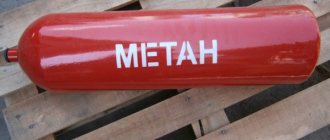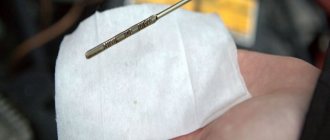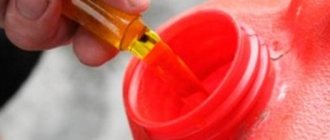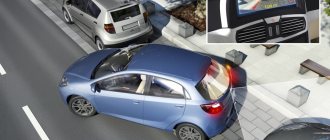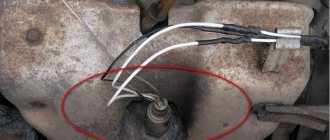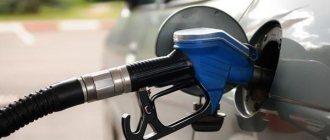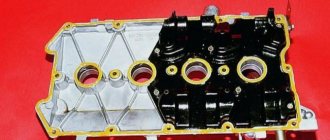Why install gas equipment
Prices for gasoline and diesel fuel are constantly rising, so many car owners are looking for alternative options, trying to save money on fuel. One of the options is gas; savings here are achieved not due to reduced fuel consumption, but due to its lower price.
Even propane-butane is two times cheaper than AI-95 gasoline or diesel fuel, not to mention methane - this gas has an even lower cost. But before convincing you to switch to gas, you should first consider the disadvantages of installing gas equipment:
- LPG equipment requires an initial investment, and it will pay for itself in approximately six months with regular use of the vehicle;
- Gas refueling cannot be done everywhere; gas stations, especially methane ones, are much smaller than gasoline ones;
- Propane is subject to fairly high safety requirements; the gas itself is explosive;
- The cylinder in the trunk of a car takes up quite a lot of space.
If we talk about the advantages of gas-cylinder equipment, then, in addition to the lower price, the following advantages can be noted:
- gas has a significantly higher octane number: if for gasoline it is 92, 95 and 98, then for propane this figure is 105.7, and for methane it is even higher - 107.5;
- with LPG installed, there are two types of fuel in the car, and if gas runs out, you can always drive on gasoline;
- Due to more complete combustion of the fuel mixture, exhaust gases become cleaner and the environment is less disrupted.
A high octane number has a positive effect on the operation of the engine - it almost never detonates, and accordingly, it is less susceptible to overheating, and the engine has a longer service life before major repairs.
Refilling the car
Filling a car with gasoline is one of the basic operations that any driver should be able to perform. When a beginner just gets behind the wheel of a car, he is a little scared at first, because he needs to take into account a lot of nuances that he hadn’t really thought about before.
Question one: when should you fill the tank with gasoline?
There is a fuel level sensor on the dashboard of any car. Its arrow gradually moves from the Full position to the Empty position.
When the level is below critical—usually 5-7 liters—the red LED lights up and notifies you that it’s time to go to the gas station.
It is not recommended that the tank be completely emptied. If this happens, the consequences will not be the most pleasant - it is difficult to start the car because the gas pump will not be able to suck gasoline into the fuel line, the engine may stall during stops at intersections, and dips in traction can be felt when turning or on uneven roads.
From this we conclude that the tank needs to be refilled on time.
Question two: where to fill up with gasoline?
There are now a lot of gas stations on our roads and in cities. Unfortunately, not everyone offers high-quality gasoline or diesel fuel. And low-quality gasoline is one of the main causes of serious engine breakdowns. The injector is very sensitive to the degree of purification of gasoline.
When choosing a gas station, consider the following factors:
- whether your friends or acquaintances refuel on it, and whether they have any complaints about the quality of gasoline;
- Do this network of gas stations give discount cards to regular customers? This is a very good way to save money, plus there are always different promotions, such as “win 1000 liters of gasoline” and so on;
- convenience of check-in, distance from home and location close to your usual routes.
Question three - how to fill a car with gasoline
The gas tank door may be located on the left or right side of the car depending on the model, so drive up to the pump on the side where your gas tank door is. The engine must be turned off while you are being refueled; this is one of the fire safety requirements.
At large gas stations there are usually gas station attendants; you just need to tell him what brand of gasoline to fill and how many liters. While the gas station attendant is busy with the hatch and hose, you go to the cash register and pay for gasoline. As soon as you pay the money, the controller will turn on the gas supply and immediately turn it off as soon as the required amount has been poured out.
If there is no refueler, then you need:
- turn off the engine and put the car on the handbrake;
- open the hatch and unscrew the tank cap;
- take the desired gun and insert it into the neck of the tank;
- fix it in this position using a special lock, go to the cashier and pay for the amount you need;
- wait until the required number of liters has poured out - unfasten the gun and hang it in place.
When you take out the gun, be careful not to let the remaining gasoline splash you. Never forget to cap the tank, because this happens very often, and finding the right cap is not always easy.
Be sure to take and save receipts from the gas station so that in case of any problems you can prove that this is where you refueled and not somewhere else.
Sometimes it happens that you have to refuel to a full tank, because you don’t know exactly how many liters you have left in the tank. In this case, you need to watch very carefully so as not to overfill the gasoline - if you see that the gasoline is already foaming near the neck, then you need to stop supplying fuel from the gun. The cashier must give you change - his display will display how many liters you filled.
Question four - if you run out of gas on the road
Situations in life are different, and sometimes gas runs out somewhere in the middle of the road, when there are several kilometers left before the gas station. If you are going on a long trip, you can take gasoline in cans with you. Canisters must be sealed.
You can stop cars passing by and ask for a few liters of gasoline or ask for gasoline in a canister. You can also ask to be towed to a gas station.
It is extremely dangerous to buy fuel from merchants on the roadside - they can fill your tank with who knows what, and then repairs will cost much more than calling a tow truck or towing.
As you can see, refueling a car is an absolutely simple operation, but even here you need to be vigilant.
We invite you to watch a video on how to refuel your iron horse at a regular gas station.
( 4 ratings, average: 5.00 out of 5)
Propane-butane or methane
Gas equipment operating on a propane-butane mixture (liquefied gas) is somewhat different from gas equipment, which is designed for methane (natural gas). Basically, the difference lies in the cylinders - methane requires high pressure, and the gas is stored under a pressure of 200 atmospheres; propane (as the propane-butane mixture is called for simplicity) requires a pressure of 15 atmospheres.
Propane has advantages:
- liquefied gas requires more compact cylinders, they don’t weigh as much and don’t take up as much space;
- propane gas stations are more common and more common;
- propane has a less pungent odor; installation of gas-cylinder equipment is cheaper.
Natural gas also has its advantages, and they are quite significant:
- methane is a more volatile fraction and easily evaporates when leaked, so operating a car on natural gas is much safer;
- Methane is cheaper than propane, and if the car is used constantly, running on this gas becomes more profitable.
Methane has another undeniable advantage, due to which it will be very profitable to convert automobile natural gas. If refueling is carried out from a household network, the cost of fuel will be even cheaper.
Any gas-cylinder equipment must undergo scheduled maintenance once a year, where the following is performed:
- eye leak test;
- replacement of filter elements.
The condition of gas cylinders should also be checked:
- metal containers - once every five years;
- metal-plastic – once every three years.
Results
Transferring a car or refueling a car with gas at home should not happen in a rush. Here it is worth carefully calculating costs and payback.
If a vehicle travels 1-2 thousand kilometers a year, then there is no need to re-equip the car. It’s another matter if the driver almost never leaves the wheel. In such a situation, switching to LPG is a chance to really reduce costs and recoup them within 3-4 months.
Before entering the territory of the CNG filling station, the driver must, if there are passengers, ask them to leave the cab.
Before starting to refuel a vehicle with CNG, the driver must:
— disconnect the on-board electrical network (ground);
— turn on the parking (hand) brake;
— remove the key from the ignition switch;
— unscrew and remove the plug from the filling valve, having previously cleaned the valve of dirt and oil;
— leave the territory of the refueling bay.
The driver is strictly prohibited from being in the box while filling the car with gas.
Before starting refueling, the filler worker must:
— check the position of the shut-off valves and the gas pressure using the pressure gauge at the gas dispenser; in this case, the gas supply valves and the throttle must be open, the spark plug valve must be closed and the gas pressure is zero;
— connect the hose of the gas filling station to the filling valve of the gas cylinder installation of the car (at the direction of the filler worker, this operation can be performed by the driver, but always under the supervision of the filler worker);
— open the filler and cylinder valves of the car’s gas cylinder installation and close the main valve;
— signal to the operator that the vehicle is ready for refueling by pressing the corresponding button on the gas pump.
The operator, having received a signal that the vehicle is ready for refueling, must refuel the vehicle's gas cylinders by appropriately switching the control keys (in remote mode) or by pressing a button on the control panel (in automatic operating mode of gas dispensers).
When refueling a car manually, the filler worker, after connecting the filling hose and opening the filling and cylinder valves (the main valve is closed), must:
— check the residual gas pressure in the gas cylinder installation of the car;
— open the valve on the gas filling station and fill the car’s cylinders with gas;
— upon completion of refueling (the gas pressure in the vehicle cylinders should be 19.6 MPa), close the gas supply valve at the gas filling station;
— close the filling valve on the gas cylinder installation of the car;
— open the valve “to the spark plug”;
— make sure using the pressure gauge installed on the gas pump that the gas pressure is zero;
— disconnect the filling hose from the vehicle fill valve;
— close the valve “to the spark plug”;
— notify the driver about the end of refueling and the amount of gas filled;
— make sure that the car leaves the CNG filling station box.
Upon completion of refueling, the driver of a gas-cylinder vehicle is obliged to:
— make payments to the CNG filling station for the supplied gas;
— make sure that the cylinders are filled and the pressure in them has stabilized;
— screw the plug onto the filling valve;
— turn on the on-board electrical network (ground);
— open the main valve (electronic gas valve);
— make sure (by ear) of the tightness of the gas equipment and the correct operation of the instrumentation;
— start the engine and leave the territory of the CNG filling station.
When filling cylinders with compressed natural gas, for safety reasons, the following rules must be observed:
— do not fill gas cylinders that have not passed the regular inspection and do not have the appropriate mark;
— do not fill cylinders with gas if a leak is detected in gas pipelines, connections or gas equipment;
— hermetically connect the hose tip to the fill valve of the car;
— do not fill gas cylinders with the main valve open;
— do not stand near the filling hose while filling cylinders;
— do not disconnect the filling hose under pressure;
— do not tighten nuts and connections under pressure;
- do not carry out any routine repairs or adjustments of gas equipment;
— do not knock with metal objects on equipment and gas pipelines under pressure;
— if the filling hose accidentally depressurizes, immediately close the filling valve to prevent gas from escaping from the vehicle cylinders.
In the event of an emergency, regardless of the refueling mode, you must press the “Emergency” button on the gas dispenser (the same button is also available on the control panel in the operator’s room).
When you press the “Emergency” button, the gas supply to the column is stopped and it is discharged from the station’s process line.
Installation of gas equipment on methane
Gas equipment has been installed on cars for a very long time, since Soviet times, but in the USSR gas fuel was not so popular - gasoline was cheap then, and they did not save on it. Now, when many people travel for commercial purposes, the cost of fuel is of great importance. Increasingly, car owners are paying attention to methane, and the point here is the nature of the gas itself. If propane-butane is a liquefied gas and is obtained through processing, then methane is a natural fuel, and it is this gas that is supplied to apartments and private houses.

